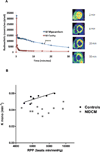Impairment of subendocardial perfusion reserve and oxidative metabolism in nonischemic dilated cardiomyopathy
- PMID: 24331202
- PMCID: PMC3945036
- DOI: 10.1016/j.cardfail.2013.10.010
Impairment of subendocardial perfusion reserve and oxidative metabolism in nonischemic dilated cardiomyopathy
Abstract
Background: Cardiac magnetic resonance (CMR) and [(11)C]acetate positron emission tomography (PET) were used to assess the hypothesis that patients with nonischemic dilated cardiomyopathy (NIDCM) have decreased subendocardial perfusion reserve and impaired oxidative metabolism, consistent with the concept of "energy starvation" in heart failure (HF).
Methods and results: CMR myocardial perfusion was evaluated in 13 NIDCM patients and 15 control subjects with coronary risk factors and normal myocardial perfusion. The NIDCM patients underwent [(11)C]acetate PET. The myocardial perfusion index (MPI) was calculated as the normalized rate of myocardial signal augmentation following gadolinium contrast injection. Hyperemic transmural, subendocardial, and subepicardial MPI were reduced in NIDCM compared with control subjects [0.13 vs 0.18 (P < .001), 0.13 vs 0.17 (P < .001), and 0.13 vs 0.17 (P = .008), respectively]. The subendocardial perfusion reserve was 1.59 ± 0.21 vs 1.86 ± 0.32 for the subepicardium (P = .002), demonstrating reduced perfusion reserve. The myocardial oxidative metabolic rate (kmono) per unit demand (rate-pressure product) was reduced in proportion to perfusion reserve (P = .02) CONCLUSIONS: Impaired subendocardial perfusion reserve in NIDCM confirmed results previously attained only in animal models. Impaired perfusion and impaired oxidative metabolism are consistent with subendocardial energy starvation in HF.
Trial registration: ClinicalTrials.gov NCT00574119.
Keywords: CMR; fibrosis; heart failure; myocardial blood flow; oxidative metabolism.
Published by Elsevier Inc.
Figures





Similar articles
-
High reproducibility of adenosine stress cardiac MR myocardial perfusion imaging in patients with non-ischaemic dilated cardiomyopathy.BMJ Open. 2014 Dec 16;4(12):e005984. doi: 10.1136/bmjopen-2014-005984. BMJ Open. 2014. PMID: 25515841 Free PMC article.
-
Antifailure therapy including spironolactone improves left ventricular energy supply-demand relations in nonischemic dilated cardiomyopathy.J Am Heart Assoc. 2014 Aug 27;3(4):e000883. doi: 10.1161/JAHA.114.000883. J Am Heart Assoc. 2014. PMID: 25164945 Free PMC article.
-
Myocardial oxidative metabolic supply-demand relationships in patients with nonischemic dilated cardiomyopathy.J Nucl Cardiol. 2006 Jul;13(4):544-53. doi: 10.1016/j.nuclcard.2006.04.002. J Nucl Cardiol. 2006. PMID: 16919578 Clinical Trial.
-
Impact of anatomical and functional severity of coronary atherosclerotic plaques on the transmural perfusion gradient: a [15O]H2O PET study.Eur Heart J. 2014 Aug 14;35(31):2094-105. doi: 10.1093/eurheartj/ehu170. Epub 2014 Apr 29. Eur Heart J. 2014. PMID: 24780500
-
Transmural steal with isoproterenol and exercise in poststenotic myocardium.Basic Res Cardiol. 1990;85 Suppl 1:145-55. doi: 10.1007/978-3-662-11038-6_12. Basic Res Cardiol. 1990. PMID: 2091604 Review.
Cited by
-
High reproducibility of adenosine stress cardiac MR myocardial perfusion imaging in patients with non-ischaemic dilated cardiomyopathy.BMJ Open. 2014 Dec 16;4(12):e005984. doi: 10.1136/bmjopen-2014-005984. BMJ Open. 2014. PMID: 25515841 Free PMC article.
-
Serum Galectin-3 and Risk Stratification in Chronic Heart Failure: A Systematic Review of Mortality Outcomes.Cureus. 2025 Jun 29;17(6):e86959. doi: 10.7759/cureus.86959. eCollection 2025 Jun. Cureus. 2025. PMID: 40734851 Free PMC article. Review.
-
Development of a multivariable model to predict vulnerability in older American patients hospitalised with cardiovascular disease.BMJ Open. 2015 Aug 27;5(8):e008122. doi: 10.1136/bmjopen-2015-008122. BMJ Open. 2015. PMID: 26316650 Free PMC article.
-
Myocardial Perfusion Imaging with Cardiovascular Magnetic Resonance in Nonischemic Cardiomyopathies: An In-Depth Review of Techniques and Clinical Applications.Medicina (Kaunas). 2025 May 10;61(5):875. doi: 10.3390/medicina61050875. Medicina (Kaunas). 2025. PMID: 40428833 Free PMC article. Review.
-
Targeted Metabolomic Profiling of Plasma and Survival in Heart Failure Patients.JACC Heart Fail. 2017 Nov;5(11):823-832. doi: 10.1016/j.jchf.2017.07.009. JACC Heart Fail. 2017. PMID: 29096792 Free PMC article.
References
-
- [accessed May 25th 2013]; http://depts.washington.edu/shfm/app.php,
-
- Katz AM. The myocardium in congestive heart failure. Am J Cardiol. 1989;63:12A–16A. - PubMed
-
- Tsagalou EP, Anastasiou-Nana M, Agapitos E, Gika A, Drakos SG, Terrovitis JV, et al. Depressed coronary flow reserve is associated with decreased myocardial capillary density in patients with heart failure due to idiopathic dilated cardiomyopathy. J Am Coll Cardiol. 2008;52:1391–1398. - PubMed
-
- Katz AM. Cardiomyopathy of overload. A major determinant of prognosis in congestive heart failure. N Engl J Med. 1990;322:100–110. - PubMed
-
- Olson RE, Schwartz WB. Myocardial metabolism in congestive heart failure. Medicine (Baltimore) 1951;30:21–41. - PubMed
Publication types
MeSH terms
Associated data
Grants and funding
LinkOut - more resources
Full Text Sources
Other Literature Sources
Medical
Research Materials
Miscellaneous

